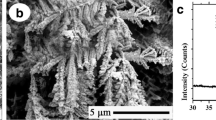Abstract
The need for reducing the energy consumption and volume of materials used in the aerospace industry has been driving the further optimization of the behavior of TiAl alloy under friction and wear. Therefore, investigating the micro-/nanostructures of the wear scar cross sections when TiAl-Ag composites slide against an immobile Si3N4 ball should help to analyze the friction and wear behaviors. Plastic deformation was observed to occur in the cross sections of the analyzed wear scar during the initial −25 min of the experiments; consequently, a work-hardened layer formed, and the friction coefficient and wear rate rapidly decreased. During the 25-60 min interval, the wear debris was refined in succession and formed a lubrication film, and the friction resistance and material loss were reduced. During the 60-120 min interval, a remarkably large amount of Ag was determined to be well distributed across the wear scar. It coincided with excellent deformation; moreover, the friction coefficients and wear rates of the TiAl-10 wt.% Ag composites were low.












Similar content being viewed by others
References
L. Fang, J.P. Lin, and X.F. Ding, Thermal Cycling Induced Microstructural Instability in Fully Lamellar Ti-45Al-8.5Nb-(W, B, Y) Alloys, Mater. Chem. Phys., 2015, 167, p 112–118
R. Chen, S. Dong, and J. Guo, Investigation of Macro/Microstructure Evolution and Mechanical Properties of Directionally Solidified High-Nb TiAl-Based Alloy, Mater. Des., 2016, 89, p 492–506
C. Yuan and X. Cheng, Investigation into the Use of CaZrO3, as a Facecoat Material in the Investment Casting of TiAl Alloys, Mater. Chem. Phys., 2015, 155(2), p 205–210
W. Wang, X.J. Liu, and K. Liu, Experimental Study on the Tribological Properties of Powder Lubrication under Plane Contact, Tribol. Trans., 2010, 53(2), p 274–279
A. Baradeswaran and A.E. Perumal, Study on Mechanical and Wear Properties of Al 7075/Al2O3/Graphite Hybrid Composites, Compos. Part B Eng., 2014, 56, p 464–471
S. Mahathanabodee, T. Palathai, S. Raadnui, R. Tongsri, and N. Sombatsompop, Dry Sliding Wear Behavior of SS316L Composites Containing h-BN and MoS2 Solid Lubricants, Wear, 2014, 316, p 37–48
Z.S. Xu, Q.X. Zhang, and X.J. Huang, An Approximate Model for the Migration of Solid Lubricant on Metal Matrix Self-lubricating Composites, Tribol. Int., 2016, 93, p 104–114
X.L. Shi, Z.S. Xu, and M. Wang, Tribological Behavior of TiAl Matrix Self-lubricating Composites Containing Silver from 25 to 800°C, Wear, 2013, 303(1–2), p 486–494
K. Yang, X.L. Shi, D. Zheng, and W.Z. Zhai, Tribological Behavior of a TiAl Matrix Composite Containing 10 wt% Ag Investigated at Four Wear Stages, RSC Adv., 2015, 5, p 77885–77896
A.M.M. Ibrahim, X.L. Shi, W.Z. Zhai, and K. Yang, Improving the Tribological Properties of NiAl Matrix Composites via Hybrid Lubricants of Silver and Graphene Nano Platelets, RSC Adv., 2015, 5(76), p 61554–61561
W.Z. Zhai and K. Zhou, Nanomaterials in Superlubricity, Adv. Funct. Mater., 2019, 1806395, p 1–19
X.Y. Liu, X.L. Shi, G.C. Lu, H.Y. Zhou, and X.B. Deng, Effect of Different Microporous Parameters on Mechanical and Frictional Properties of M50 Self-lubricating Materials: Simulation Analysis and Experimental Study, Mater. Res. Express, 2019, 056502(6), p 1–14
X.Y. Liu, X.L. Shi, Y.C. Huang, X.B. Deng, and G.C. Lu, Tribological Behavior and Self-healing Functionality of M50 Material Covered with Surface Micropores Filled with Sn-Ag-Cu, Tribol. Int., 2018, 128, p 365–375
Y. Xu, Y. Peng, K.D. Dearn, X. Zheng, L. Yao, and X. Hu, Synergistic Lubricating Behaviors of Graphene and MoS2 Dispersed in Esterified Bio-oil for Steel/Steel Contact, Wear, 2015, 342, p 297–309
Y.L. Yue, H.T. Wu, B. Wu, Z.J. Wang, and W.H. Tao, Thermodynamic and Dynamics Analysis on the Combustion Synthesis of TiAl Intermetallic, J. Univ. **an (in Chinese), 2005, 19(2), p 106–109
ASTM E92-82, Standard Test Method for Vickers Hardness of Metallic Materials, ASTM International, West Conshohocken, 2003
ASTM B962-08, Standard Test Methods for Density of Compacted or Sintered Powder Metallurgy (PM) Products Using Archimedes’ Principle, ASTM International, West Conshohocken, 2008
ASTM G99-95, Standard Test Method for Wear Testing with a Pin-on-Disk Apparatus, ASTM International, West Conshohocken, 1995
O. Bouaziz and P. Buessler, Iso-work Increment Assumption for Heterogeneous Material Behavior Modelling, Adv. Eng. Mater., 2004, 79, p 79–83
Z. Hashin, The Inelastic Inclusion Problem, Int. J. Eng. Sci., 1969, 7(1), p 11–36
Acknowledgments
This work is supported by China postdoctoral Science Foundation (2019M662484), Henan postdoctoral Foundation and postdoctoral Foundation (BHJ2019006), as well as Doctoral Start-up Funding (BSJ2018005) of Anyang Institute of Technology, Foundation of Henan Educational Committee (19A460011), Project for Science and Technology Plan of Henan Province (192102210010), Tribology Science Fund of State Key Laboratory of Tribology (SKLTKF18B09), and Sichuan Provincial Key Lab of Process Equipment and Control (GK201901). Authors are also appreciative to Nan**g XFNANO Materials Tech Co., Ltd., for their kind assistance.
Author information
Authors and Affiliations
Corresponding author
Additional information
Publisher's Note
Springer Nature remains neutral with regard to jurisdictional claims in published maps and institutional affiliations.
Appendix
Appendix
where mx, ρx, υx, φx, and Ex are named as additive amount, material density, Poisson’s ratio, and Young’s modulus. x is termed as sliver, TiAl alloys, or TiAl-Ag materials. a is contact radius of Hertzian. RSi3N4 is ball radius. Ff is friction force. σTiAl-Ag is von Mises stress. Tkm is a thickness of micro-deformation layer. Dtw and Tkpy are the depth and thickness of wear scars. y is known as the numbers of sliding cycles.
Rights and permissions
About this article
Cite this article
Li, F., Yang, K., Ma, H. et al. Analysis of In Situ Synthesis and Cross-Sectional Evolution of Wear Scars of TiAl-Ag Composites. J. of Materi Eng and Perform 29, 2514–2523 (2020). https://doi.org/10.1007/s11665-020-04664-6
Received:
Revised:
Published:
Issue Date:
DOI: https://doi.org/10.1007/s11665-020-04664-6




